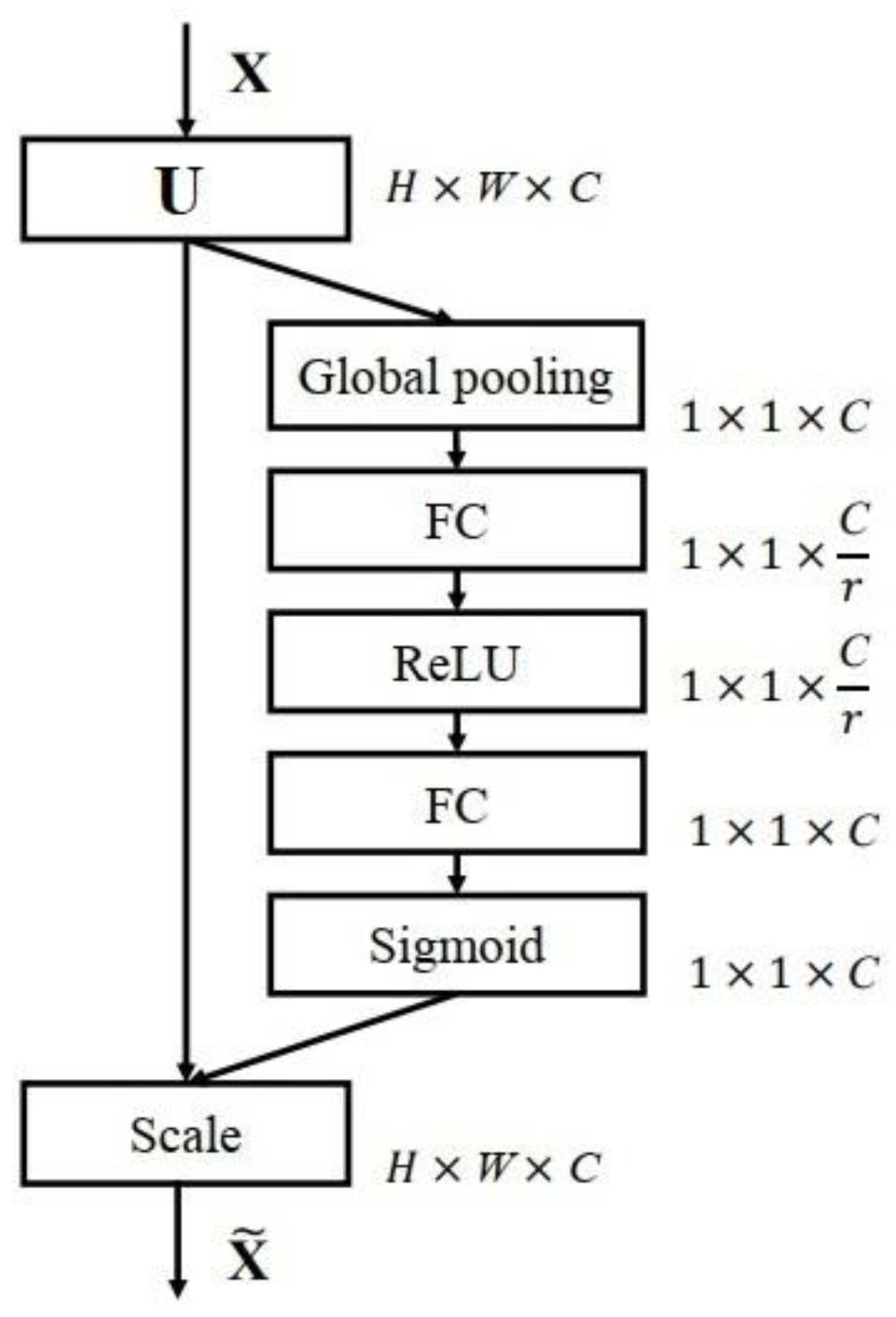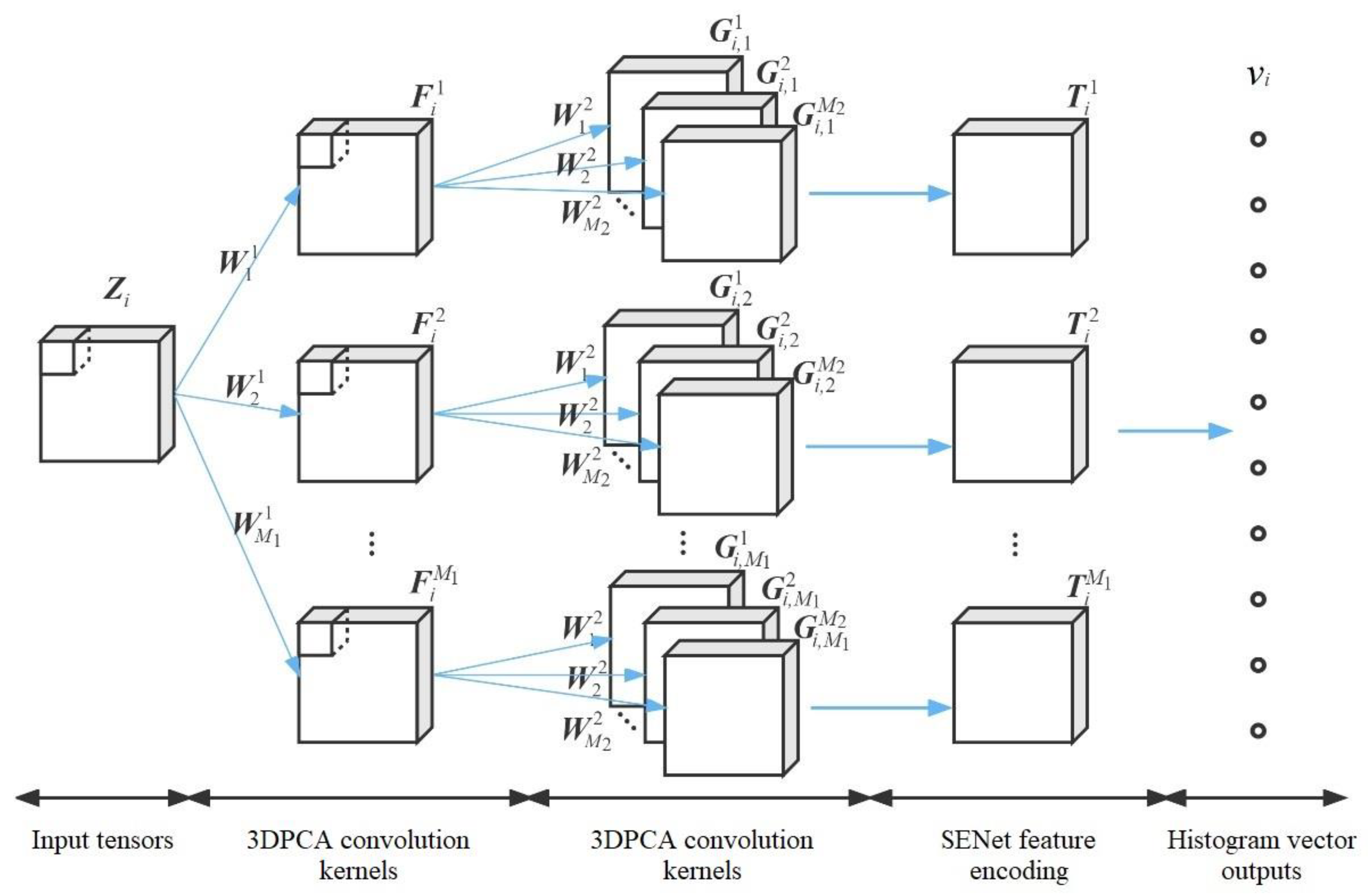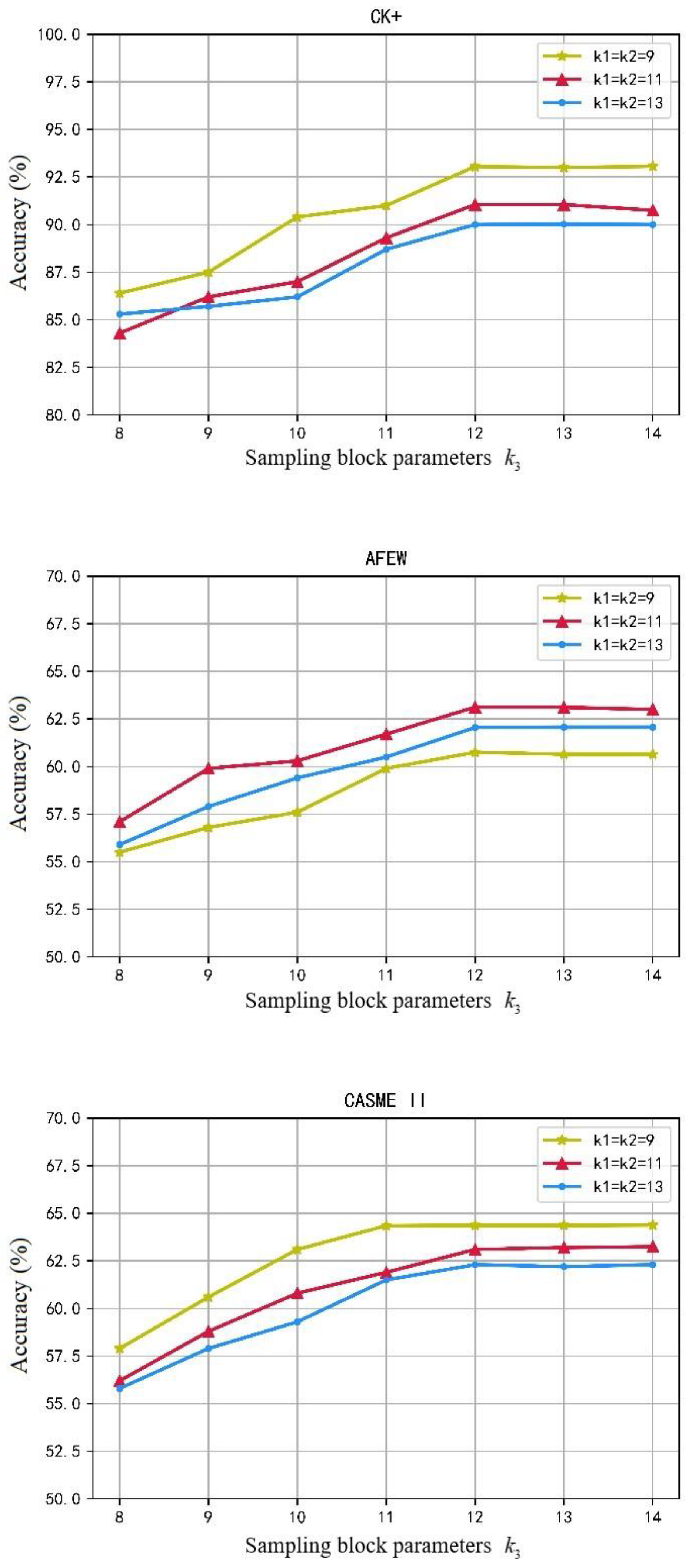A Video Sequence Face Expression Recognition Method Based on Squeeze-and-Excitation and 3DPCA Network
Abstract
1. Introduction
2. Preliminaries
2.1. Tensor Representations and Operations
2.1.1. n-Mode Product
2.1.2. Inner Product
2.1.3. Outer Product
2.1.4. Kronecker Product
2.2. Three-Dimensional Principal Component Analysis (3DPCA)
2.3. Squeeze-and-Excitation Net (SENet)
3. A Video Sequence Face Expression Recognition Method Based on SE-3DPCANet
3.1. Two-Order Convolutional Layers Based on 3DPCA
3.2. Feature Encoding Layer Based on the Channel Attention Mechanism
4. Case Study
4.1. Introduction to the Data Set and Preprocessing
4.2. Experiment 1: Selection of Model Parameters
4.3. Experiment 2: Algorithm Performance Comparison and Analysis
5. Conclusions
Author Contributions
Funding
Institutional Review Board Statement
Informed Consent Statement
Data Availability Statement
Conflicts of Interest
References
- Sown, M. A preliminary note on pattern recognition of facial emotional expression. In Proceedings of the 4th International Joint Conferences on Pattern Recognition, Kyoto, Japan, 7–10 November 1978. [Google Scholar]
- Jain, A.K.; Li, S.Z. Handbook of Face Recognition; Springer: Berlin/Heidelberg, Germany, 2011; Volume 1. [Google Scholar]
- Shan, C.; Gong, S.; McOwan, P.W. Facial expression recognition based on local binary patterns: A comprehensive study. Image Vis. Comput. 2009, 27, 803–816. [Google Scholar] [CrossRef]
- Cohen, I.; Sebe, N.; Garg, A.; Chen, L.S.; Huang, T.S. Facial expression recognition from video sequences: Temporal and static modeling. Comput. Vis. Image Underst. 2003, 91, 160–187. [Google Scholar] [CrossRef]
- Chibelushi, C.C.; Bourel, F. Facial expression recognition: A brief tutorial overview. CVonline-Line Compend. Comput. Vis. 2003, 9. [Google Scholar]
- Rodger, H.; Vizioli, L.; Ouyang, X.; Caldara, R. Mapping the development of facial expression recognition. Dev. Sci. 2015, 18, 926–939. [Google Scholar] [CrossRef] [PubMed]
- Wang, K.; Peng, X.; Yang, J.; Lu, S.; Qiao, Y. Suppressing uncertainties for large-scale facial expression recognition. In Proceedings of the IEEE/CVF conference on Computer Vision and Pattern Recognition, Seattle, WA, USA, 13–19 June 2020; pp. 6897–6906. [Google Scholar]
- Chen, X.-W.; Huang, T. Facial expression recognition: A clustering-based approach. Pattern Recognit. Lett. 2003, 24, 1295–1302. [Google Scholar] [CrossRef]
- Kimura, S.; Yachida, M. Facial expression recognition and its degree estimation. In Proceedings of the IEEE Computer Society Conference on Computer Vision and Pattern Recognition, San Juan, Puerto Rico, 17–19 June 1997; pp. 295–300. [Google Scholar]
- Michel, P.; El Kaliouby, R. Real time facial expression recognition in video using support vector machines. In Proceedings of the 5th International Conference on Multimodal Interfaces, Vancouver, BC, Canada, 5–7 November 2003; pp. 258–264. [Google Scholar]
- Wang, S.; Liu, Z.; Lv, S.; Lv, Y.; Wu, G.; Peng, P.; Chen, F.; Wang, X. A natural visible and infrared facial expression database for expression recognition and emotion inference. IEEE Trans. Multimed. 2010, 12, 682–691. [Google Scholar] [CrossRef]
- Mohammadi, M.R.; Fatemizadeh, E.; Mahoor, M.H. PCA-based dictionary building for accurate facial expression recognition via sparse representation. J. Vis. Commun. Image Represent. 2014, 25, 1082–1092. [Google Scholar] [CrossRef]
- Patil, M.N.; Iyer, B.; Arya, R. Performance evaluation of PCA and ICA algorithm for facial expression recognition application. In Proceedings of the Fifth International Conference on Soft Computing for Problem Solving; Springer: Singapore, 2016; pp. 965–976. [Google Scholar]
- Luo, Y.; Wu, C.-m.; Zhang, Y. Facial expression recognition based on fusion feature of PCA and LBP with SVM. Opt.-Int. J. Light Electron Opt. 2013, 124, 2767–2770. [Google Scholar] [CrossRef]
- Deng, H.-B.; Jin, L.-W.; Zhen, L.-X.; Huang, J.-C. A new facial expression recognition method based on local Gabor filter bank and PCA plus LDA. Int. J. Inf. Technol. 2005, 11, 86–96. [Google Scholar]
- Buciu, I.; Pitas, I. Application of non-negative and local non negative matrix factorization to facial expression recognition. In Proceedings of the 17th International Conference on Pattern Recognition, ICPR 2004, Cambridge, UK, 26 August 2004; pp. 288–291. [Google Scholar]
- Lien, J.J.; Kanade, T.; Cohn, J.F.; Li, C.-C. Automated facial expression recognition based on FACS action units. In Proceedings of the Third IEEE International Conference on Automatic Face and Gesture Recognition, Nara, Japan, 14–16 April 1998; pp. 390–395. [Google Scholar]
- Buciu, I.; Kotropoulos, C.; Pitas, I. Comparison of ICA approaches for facial expression recognition. Signal Image Video Process. 2009, 3, 345–361. [Google Scholar] [CrossRef]
- Guo, X.; Zhang, X.; Deng, C.; Wei, J. Facial Expression Recognition based on Independent Component Analysis. J. Multimed. 2013, 8, 402–409. [Google Scholar] [CrossRef]
- Varma, S.; Shinde, M.; Chavan, S.S. Analysis of PCA and LDA features for facial expression recognition using SVM and HMM classifiers. In Techno-Societal 2018; Springer: Berlin/Heidelberg, Germany, 2020; pp. 109–119. [Google Scholar]
- Wu, T.; Bartlett, M.S.; Movellan, J.R. Facial expression recognition using gabor motion energy filters. In Proceedings of the 2010 IEEE Computer Society Conference on Computer Vision and Pattern Recognition-Workshops, San Francisco, CA, USA, 13–18 June 2010; pp. 42–47. [Google Scholar]
- Gu, W.; Xiang, C.; Venkatesh, Y.; Huang, D.; Lin, H. Facial expression recognition using radial encoding of local Gabor features and classifier synthesis. Pattern Recognit. 2012, 45, 80–91. [Google Scholar] [CrossRef]
- Ou, J.; Bai, X.-B.; Pei, Y.; Ma, L.; Liu, W. Automatic facial expression recognition using Gabor filter and expression analysis. In Proceedings of the 2010 Second International Conference on Computer Modeling and Simulation, Sanya, China, 22–24 January 2010; pp. 215–218. [Google Scholar]
- Liu, W.; Wang, Z. Facial expression recognition based on fusion of multiple Gabor features. In Proceedings of the 18th International Conference on Pattern Recognition (ICPR’06), Hong Kong, China, 20–24 August 2006; pp. 536–539. [Google Scholar]
- Almaev, T.R.; Valstar, M.F. Local gabor binary patterns from three orthogonal planes for automatic facial expression recognition. In Proceedings of the 2013 Humaine Association Conference on Affective Computing and Intelligent Interaction, Geneva, Switzerland, 2–5 September 2013; pp. 356–361. [Google Scholar]
- Ahsan, T.; Jabid, T.; Chong, U.-P. Facial expression recognition using local transitional pattern on Gabor filtered facial images. IETE Tech. Rev. 2013, 30, 47–52. [Google Scholar] [CrossRef]
- Ding, Y.; Zhao, Q.; Li, B.; Yuan, X. Facial expression recognition from image sequence based on LBP and Taylor expansion. IEEE Access 2017, 5, 19409–19419. [Google Scholar] [CrossRef]
- Shan, C.; Gritti, T. Learning Discriminative LBP-Histogram Bins for Facial Expression Recognition. In Proceedings of the BMVC, Leeds, UK, 1–8 September 2008; pp. 1–10. [Google Scholar]
- Shan, C.; Gong, S.; McOwan, P.W. Robust facial expression recognition using local binary patterns. In Proceedings of the IEEE International Conference on Image Processing, Geneva, Switzerland, 11–14 September 2005. [Google Scholar]
- Huang, M.-W.; Wang, Z.-W.; Ying, Z.-L. A new method for facial expression recognition based on sparse representation plus LBP. In Proceedings of the 2010 3rd International Congress on Image and Signal Processing, Yantai, China, 16–18 October 2010; pp. 1750–1754. [Google Scholar]
- He, L.; Zou, C.; Zhao, L.; Hu, D. An enhanced LBP feature based on facial expression recognition. In Proceedings of the 2005 IEEE Engineering in Medicine and Biology 27th Annual Conference, Shanghai, China, 17–18 January 2006; pp. 3300–3303. [Google Scholar]
- Kong, F. Facial expression recognition method based on deep convolutional neural network combined with improved LBP features. Pers. Ubiquitous Comput. 2019, 23, 531–539. [Google Scholar] [CrossRef]
- Tuncer, T.; Dogan, S.; Akbal, E. Discrete complex fuzzy transform based face image recognition method. Int. J. Image Graph. Signal Process 2019, 11, 1–7. [Google Scholar] [CrossRef]
- Tuncer, T.; Dogan, S.; Abdar, M.; Ehsan Basiri, M.; Pławiak, P. Face recognition with triangular fuzzy set-based local cross patterns in wavelet domain. Symmetry 2019, 11, 787. [Google Scholar] [CrossRef]
- Tu, D.-W.; Jiang, J.-L. Improved algorithm for motion image analysis based on optical flow and its application. Guangxue Jingmi Gongcheng 2011, 19, 1159–1164. [Google Scholar]
- Song, X.; Seneviratne, L.D.; Althoefer, K. A Kalman filter-integrated optical flow method for velocity sensing of mobile robots. IEEE/ASME Trans. Mechatron. 2010, 16, 551–563. [Google Scholar] [CrossRef]
- Horn, B.K.; Schunck, B.G. Determining optical flow. Artif. Intell. 1981, 17, 185–203. [Google Scholar] [CrossRef]
- Brox, T.; Bruhn, A.; Papenberg, N.; Weickert, J. High accuracy optical flow estimation based on a theory for warping. In Proceedings of the European Conference on Computer Vision, Prague, Czech Republic, 11–14 May 2004; pp. 25–36. [Google Scholar]
- Lei, Y.; Jinzong, L.; Dongdong, L. Discontinuity-preserving optical flow algorithm. J. Syst. Eng. Electron. 2007, 18, 347–354. [Google Scholar] [CrossRef]
- Bruhn, A.; Weickert, J.; Schnörr, C. Lucas/Kanade meets Horn/Schunck: Combining local and global optic flow methods. Int. J. Comput. Vis. 2005, 61, 211–231. [Google Scholar] [CrossRef]
- Tran, D.; Bourdev, L.; Fergus, R.; Torresani, L.; Paluri, M. Learning spatiotemporal features with 3d convolutional networks. In Proceedings of the IEEE International Conference on Computer Vision, Santiago, Chile, 11–18 December 2015; pp. 4489–4497. [Google Scholar]
- He, X.; Xu, J.; Shi, K.; Chen, W. Video face expression recognition based on attention mechanism. Inf. Technol. 2020, 44, 103–107. [Google Scholar] [CrossRef]
- Wang, Z.; Hou, T.; Heng, X. Fusing CNN and BLSTM neural networks for facial expression recognition. Comput. Digit. Eng. 2020, 48, 2978–2983. [Google Scholar]
- Vielzeuf, V.; Pateux, S.; Jurie, F. Temporal multimodal fusion for video emotion classification in the wild. In Proceedings of the 19th ACM International Conference on Multimodal Interaction, Glasgow, UK, 13–17 November 2017; pp. 569–576. [Google Scholar]
- Wang, Q.; Wang, K.; Li, Y.; Wang, X.; Wang, B. Fast 3D principal component analysis-based lung CT image detection. Opt. Precis. Eng. 2010, 18, 2695–2701. [Google Scholar]
- Lathauwer, L.D.; Moor, B.D.; Vandewalle, J. A Multilinear Singular Value Decomposition. SIAM J. Matrix Anal. Appl. 2000, 21, 1253–1278. [Google Scholar] [CrossRef]
- Hu, J.; Shen, L.; Sun, G. Squeeze-and-Excitation Networks. In Proceedings of the IEEE Conference on Computer Vision and Pattern Recognition, Salt Lake City, UT, USA, 18–23 June 2018; pp. 7132–7141. [Google Scholar]
- Lucey, P.; Cohn, J.F.; Kanade, T.; Saragih, J.; Ambadar, Z.; Matthews, I. The Extended Cohn-Kanade Dataset (CK+): A complete dataset for action unit and emotion-specified expression. In Proceedings of the 2010 IEEE Computer Society Conference on Computer Vision and Pattern Recognition—Workshops, San Francisco, CA, USA, 13–18 June 2010; pp. 94–101. [Google Scholar]
- Dhall, A.; Goecke, R.; Lucey, S.; Gedeon, T. Collecting Large, Richly Annotated Facial-Expression Databases from Movies. IEEE MultiMedia 2012, 19, 34–41. [Google Scholar] [CrossRef]
- Yan, W.J.; Li, X.; Wang, S.J.; Zhao, G.; Liu, Y.J.; Chen, Y.H.; Fu, X. CASME II: An Improved Spontaneous Micro-Expression Database and the Baseline Evaluation. PLoS ONE 2014, 9, e86041. [Google Scholar] [CrossRef]
- Vaswani, A.; Shazeer, N.; Parmar, N.; Uszkoreit, J.; Jones, L.; Gomez, A.N.; Kaiser, Ł.; Polosukhin, I. Attention is all you need. In Proceedings of the 31st Conference on Neural Information Processing Systems, Long Beach, CA, USA, 4–9 December 2017. [Google Scholar]
- Chen, X.; He, L.; Du, Q. Expression Recognition Based on KPCANet and Linear Discriminant Analysis. J. Huazhong Univ. Sci. Technol. (Nat. Sci. Ed.) 2020, 48, 95–99. [Google Scholar] [CrossRef]
- Li, S.; Deng, W. Deep Facial Expression Recognition: A Survey. IEEE Trans. Affect. Comput. 2022, 13, 1195–1215. [Google Scholar] [CrossRef]
- Ma, A. Research on Video Oriented Dynamic Facial Expression Recognition Algorithm. Master’s Thesis, Jilin University, Changchun, China, 2021. [Google Scholar]
- Park, S.Y.; Lee, S.H.; Ro, Y.M. Subtle Facial Expression Recognition Using Adaptive Magnification of Discriminative Facial Motion. In Proceedings of the 23rd ACM International Conference on Multimedia, Brisbane, Australia, 26–30 October 2015; pp. 911–914. [Google Scholar]
- Li, X.; Hong, X.; Moilanen, A.; Huang, X.; Pfister, T.; Zhao, G.; Pietikäinen, M. Towards Reading Hidden Emotions: A Comparative Study of Spontaneous Micro-Expression Spotting and Recognition Methods. IEEE Trans. Affect. Comput. 2018, 9, 563–577. [Google Scholar] [CrossRef]
- Kim, D.H.; Baddar, W.J.; Ro, Y.M. Micro-Expression Recognition with Expression-State Constrained Spatio-Temporal Feature Representations. In Proceedings of the 24th ACM International Conference on Multimedia, Amsterdam, The Netherlands, 15–19 October 2016; pp. 382–386. [Google Scholar]








| Algorithms | Recognition Rate (%) | Training Time (hours) |
|---|---|---|
| 3D-CNN [44] | 92.43 | >24 |
| 3D Inception-ResNet [44] | 93.21 | >12 |
| Spatio-temporal manifold [51] | 94.20 | 10 |
| PCANet | 88.65 | 0.381 |
| KPCANet-LDA [52] | 91.32 | - |
| 3D-PCANet | 92.67 | 0.524 |
| SE-3DPCANet | 93.15 | 0.568 |
Disclaimer/Publisher’s Note: The statements, opinions and data contained in all publications are solely those of the individual author(s) and contributor(s) and not of MDPI and/or the editor(s). MDPI and/or the editor(s) disclaim responsibility for any injury to people or property resulting from any ideas, methods, instructions or products referred to in the content. |
© 2023 by the authors. Licensee MDPI, Basel, Switzerland. This article is an open access article distributed under the terms and conditions of the Creative Commons Attribution (CC BY) license (https://creativecommons.org/licenses/by/4.0/).
Share and Cite
Li, C.; Wen, C.; Qiu, Y. A Video Sequence Face Expression Recognition Method Based on Squeeze-and-Excitation and 3DPCA Network. Sensors 2023, 23, 823. https://doi.org/10.3390/s23020823
Li C, Wen C, Qiu Y. A Video Sequence Face Expression Recognition Method Based on Squeeze-and-Excitation and 3DPCA Network. Sensors. 2023; 23(2):823. https://doi.org/10.3390/s23020823
Chicago/Turabian StyleLi, Chang, Chenglin Wen, and Yiting Qiu. 2023. "A Video Sequence Face Expression Recognition Method Based on Squeeze-and-Excitation and 3DPCA Network" Sensors 23, no. 2: 823. https://doi.org/10.3390/s23020823
APA StyleLi, C., Wen, C., & Qiu, Y. (2023). A Video Sequence Face Expression Recognition Method Based on Squeeze-and-Excitation and 3DPCA Network. Sensors, 23(2), 823. https://doi.org/10.3390/s23020823






